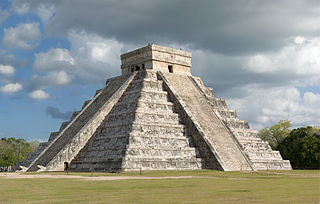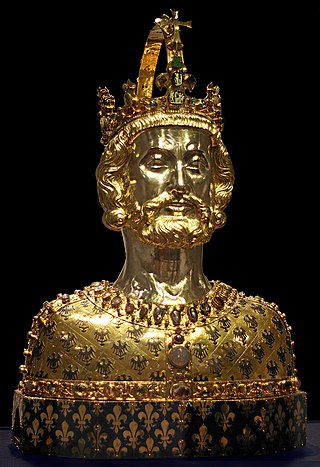
The Big history of North America encompasses the past developments of people populating the continent of North America. While it was commonly accepted that the continent first became inhabited by humans when individuals migrated across the Bering Sea 40,000 to 17,000 years ago, more recent discoveries may have pushed those estimates back at least another 90,000 years. People settled throughout the continent and, over time, developed into diverse communities, from the Inuit in the far north to the Mayans and Aztecs in the south. These complex communities each developed their own unique cultures and ways of life.

The Aztecs were a Mesoamerican civilization that flourished in central Mexico in the post-classic period from 1300 to 1521. The Aztec people included different ethnic groups of central Mexico, particularly those groups who spoke the Nahuatl language and who dominated large parts of Mesoamerica from the 14th to the 16th centuries. Aztec culture was organized into city-states (altepetl), some of which joined to form alliances, political confederations, or empires. The Aztec Empire was a confederation of three city-states established in 1427: Tenochtitlan, the capital city of the Mexica or Tenochca, Tetzcoco, and Tlacopan, previously part of the Tepanec empire, whose dominant power was Azcapotzalco. Although the term Aztecs is often narrowly restricted to the Mexica of Tenochtitlan, it is also broadly used to refer to Nahua polities or peoples of central Mexico in the prehispanic era, as well as the Spanish colonial era (1521–1821). The definitions of Aztec and Aztecs have long been the topic of scholarly discussion ever since German scientist Alexander von Humboldt established its common usage in the early 19th century.

In the history of the Americas, the pre-Columbian era, also known as the pre-contact era, spans from the initial peopling of the Americas in the Upper Paleolithic to the onset of European colonization, which began with Christopher Columbus's voyage in 1492. This era encompasses the history of Indigenous cultures prior to significant European influence, which in some cases did not occur until decades or even centuries after Columbus's arrival.

Warhammer Fantasy is a fictional fantasy universe created by Games Workshop and used in many of its games, including the table top wargame Warhammer Fantasy Battle, the Warhammer Fantasy Roleplay (WFRP) pen-and-paper role-playing game, and a number of video games: the MMORPG Warhammer Online: Age of Reckoning, the strategy games Total War: Warhammer, Total War: Warhammer II and Total War: Warhammer III and the two first-person shooter games in the Warhammer Vermintide series, Warhammer: End Times - Vermintide and Warhammer: Vermintide 2, among many others.

Age of Empires III is a real-time strategy video game developed by Microsoft Corporation's Ensemble Studios and published by Microsoft Game Studios. The Mac version was ported over and developed and published by Destineer's MacSoft. The PC version was released on October 18, 2005, in North America and November 4, 2005, in Europe, while the Mac version was released on November 21, 2006, in North America and September 29, 2006, in Europe. An N-Gage version of the game developed by Glu Mobile was released on April 28, 2009. It is the third game of the Age of Empires series and the sequel to Age of Empires II: The Age of Kings. A remaster titled Age of Empires III: Definitive Edition was released on October 15, 2020. Its successor, Age of Empires IV was released October 28, 2021, for Windows.

Ronald Wright is a Canadian author who has written books of travel, history and fiction. His nonfiction includes the bestseller Stolen Continents, winner of the Gordon Montador Award and chosen as a book of the year by The Independent and the Sunday Times. His first novel, A Scientific Romance, won the 1997 David Higham Prize for Fiction and was chosen a book of the year by the Globe and Mail, the Sunday Times, and The New York Times.

Jerónimo de Aguilar O.F.M. (1489–1531) was a Franciscan friar born in Écija, Spain. Aguilar was sent to Panama to serve as a missionary. He was later shipwrecked on the Yucatán Peninsula in 1511 and captured by the Maya. In 1519 Hernán Cortés rescued Aguilar and engaged him as a translator during the Spanish conquest of the Aztec Empire.
The Maztica Trilogy is a series of three fantasy novels that take place in the Forgotten Realms campaign setting of the Dungeons & Dragons fantasy role-playing game. The books are set in the fictional land of Maztica.
The lost world is a subgenre of the fantasy or science fiction genres that involves the discovery of an unknown Earth civilization. It began as a subgenre of the late-Victorian adventure romance and remains popular into the 21st century.

The Aztec religion is a polytheistic and monistic pantheism in which the Nahua concept of teotl was construed as the supreme god Ometeotl, as well as a diverse pantheon of lesser gods and manifestations of nature. The popular religion tended to embrace the mythological and polytheistic aspects, and the Aztec Empire's state religion sponsored both the monism of the upper classes and the popular heterodoxies.

Slavery in the Aztec Empire and surrounding Mexica societies was widespread, with slaves known by the Nahuatl word, tlacotli. Slaves did not inherit their status; people were enslaved as a form of punishment, after capturing in war, or voluntarily to pay off debts. Within Mexica society, slaves constituted an important class.

Space Viking is a science fiction novel by American writer H. Beam Piper, set in his Terro-Human future history. It tells the story of one man's search for his wife's murderer and its unexpected consequences. The story was originally serialized in Analog magazine, then published by Ace Books in 1963.

Fireball is the first book in a trilogy by John Christopher, published in 1981, exploring the adventures of two cousins when they are suddenly transported into an alternative history Earth through a mysterious fireball.

"Sidewise in Time" is a science fiction short story by American writer Murray Leinster that was first published in the June 1934 issue of Astounding Stories. "Sidewise in Time" served as the title story for Leinster's second story collection in 1950.

Beyond Thirty is a short science fiction novel by American writer Edgar Rice Burroughs. It was written in 1915 and first published in All Around Magazine in February 1916, but did not appear in book form in Burroughs' lifetime. The first book edition was issued by Lloyd Arthur Eshbach's Fantasy Press fanzine in 1955; it then appeared in the collection Beyond Thirty and The Man-Eater, published by Science-Fiction & Fantasy Publications in 1957. The work was retitled The Lost Continent for the first mass-market paperback edition, published by Ace Books in October 1963; all subsequent editions bore the new title until the Bison Books edition of March 2001, which restored the original title.

The Gate of Worlds is an alternate history novel by American writer Robert Silverberg. It was first published by Holt, Rinehart & Winston in the United States in 1967. The first UK hardcover edition was published by Gollancz in 1978.

King is the title given to a male monarch in a variety of contexts. A king is an absolute monarch if he holds the powers of government without control, or the entire sovereignty over a nation; he is a limited monarch if his power is restrained by fixed laws; and he is an absolute, when he holds the whole legislative, judicial, and executive power, or when the legislative or judicial powers, or both, are vested in other people by the king. Kings are hereditary sovereigns when they hold the powers of government by right of birth or inheritance, and elective when raised to the throne by choice.

Thongor Fights the Pirates of Tarakus is a fantasy novel by American writer Lin Carter, the sixth book of his Thongor series set on the mythical continent of Lemuria. It was first published in paperback by Berkley Medallion in July 1970, and reprinted in June 1976. The first British edition was published in paperback by Tandem in August 1971, and reissued by Star in April 1979. The book has been translated into Japanese and French.
Bibliography of science fiction, fantasy, historical fiction and nonfiction writer Harry Turtledove:

Atomik Aztex is a 2005 speculative fiction alternate history novel by Sesshu Foster. The novel combines elements of speculative fiction, alternate history, postcolonial literature, and metafiction. The narrative deals with interconnected alternate timelines, one of which is set in a reality where the Aztec Empire defeated the Spanish and then conquered Europe.

















